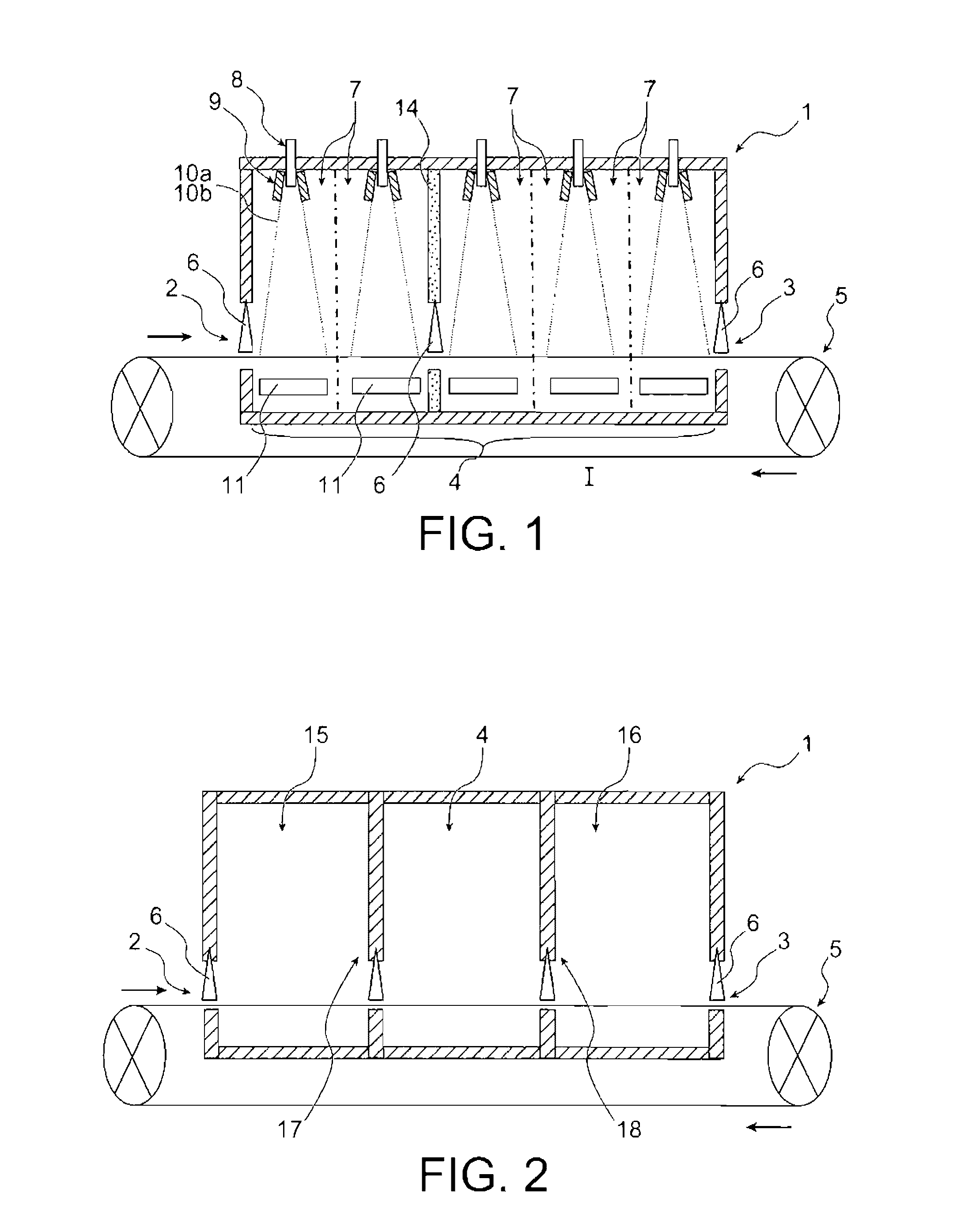Method for continuous production of aligned nanostructures on a running substrate and related device
a technology of aligned nanostructures and running substrates, which is applied in the direction of aligned nanotubes, organic compounds/hydrides/coordination complexes, physical/chemical process catalysts, etc., can solve the problems of limited cvd method by pre-deposition, large complexity of the steps sequence, and limited catalyst life. achieve the effect of improving the chemical compatibility of nanostructures
- Summary
- Abstract
- Description
- Claims
- Application Information
AI Technical Summary
Benefits of technology
Problems solved by technology
Method used
Image
Examples
examples 1a , 1b and 1c
Examples 1a, 1b and 1c
Making and Characterising a Dense Carpet of Aligned Carbon Nanotubes, Obtained According to a Synthesis Protocol Based on One or More Time Sequences (Stationary Substrate)
[0123]In this example, a CVD enclosure is used, the reaction chamber of which is a horizontally provided quartz tube in which a stationary substrate is positioned before growing the nanostructures (typically a laboratory device as described in document [7]).
[0124]The precursor (catalytic+source) mixture required for growing the nanostructures is sequentially injected over time, each of the sequences being characterised by a different concentration of the catalytic precursor in the case when there are at least two sequences.
[0125]Examples 1a, 1 and 1c below will enable characteristics both about synthesis (yields) and nanotubes thus obtained (purity, growth speed, diameters, etc.) to be measured and optimum ranges of synthesis parameters to be determined.
example 1a
Injection of a Constant Concentration of Ferrocene During One Single Sequence
[0126]FIGS. 4a to 9b show the results obtained by continuously injecting in a single sequence a constant concentration of ferrocene in the toluene / ferrocene mixture with, in particular, the effect of different concentrations of ferrocene (between 0.01 and 2.5% by weight for the different syntheses, with respectively 0.01, 0.05, 0.1, 0.25, 1, 2.5% by weight for samples 1 to 6) on the characteristics of the method and the nanotubes obtained.
[0127]The nanotubes are synthesised at a temperature of 800° C. by using an argon / H2 mixture (70 / 30% vol) as a carrier gas, for a time period of 15 minutes.
[0128]FIGS. 4a, 4b and 4c respectively represent the variations in the residual iron content in the samples (FIG. 4a), catalytic yield (FIG. 4b) and growth speed (FIG. 4c) as a function of the concentration of ferrocene implemented.
[0129]The iron content is measured by thermogravimetric analysis (TGA) under the air: the...
example 1b
Injection of a Constant Concentration of Ferrocene During One Single Sequence in the Presence of a Reactive Fluid (Acetylene)
[0142]FIGS. 10a-b and 11a-b show the results obtained by continuously injecting in a single sequence a constant concentration of ferrocene in the toluene / ferrocene mixture (10% by weight) with, in particular, the effect of the reactive fluid (acetylene) on the characteristics of the method and the nanotubes obtained.
[0143]The nanotubes are synthesised at a temperature of 800° C. by using a gaseous mixture Ar / H2 / C2H2 (0.70 / 0.30 / 0.03 L·min−1) with Ar as a carrier gas and H2 / C2H2 as a reactive fluid, for a time period of 15 minutes.
[0144]FIG. 10a illustrates the morphology of the nanotubes observed by SEM scanning electron microscopy) at the surface of the quartz support. It is observed that carbon nanotubes obtained are aligned, long, and contain a very small amount of impurities (residual catalyst (iron)-based particles), disorganised carbon particles).
[0145]Th...
PUM
| Property | Measurement | Unit |
|---|---|---|
| diameter | aaaaa | aaaaa |
| temperature | aaaaa | aaaaa |
| temperature | aaaaa | aaaaa |
Abstract
Description
Claims
Application Information
 Login to View More
Login to View More - R&D
- Intellectual Property
- Life Sciences
- Materials
- Tech Scout
- Unparalleled Data Quality
- Higher Quality Content
- 60% Fewer Hallucinations
Browse by: Latest US Patents, China's latest patents, Technical Efficacy Thesaurus, Application Domain, Technology Topic, Popular Technical Reports.
© 2025 PatSnap. All rights reserved.Legal|Privacy policy|Modern Slavery Act Transparency Statement|Sitemap|About US| Contact US: help@patsnap.com



